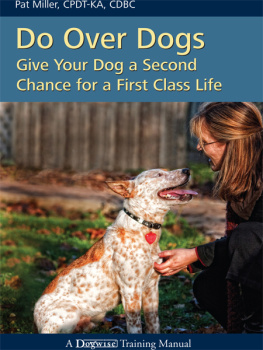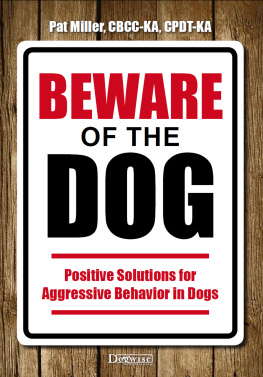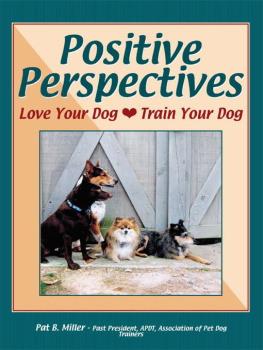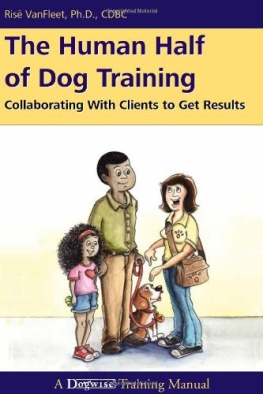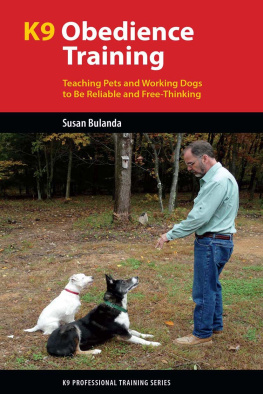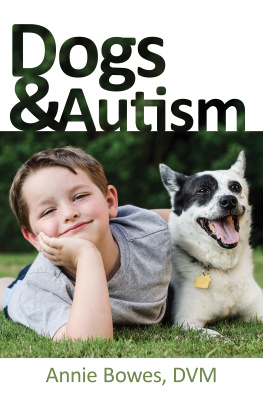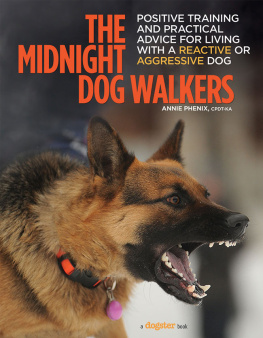
DO OVER DOGS
Give Your Dog a Second Chance for a First Class Life
Pat Miller, CPDT-KA, CDBC

Do Over Dogs
Give Your Dog a Second Chance for a First Class Life
Pat Miller
Dogwise Publishing
A Division of Direct Book Service, Inc.
403 South Mission Street, Wenatchee, Washington 98801
1-509-663-9115, 1-800-776-2665
www.dogwisepublishing.com / info@dogwisepublishing.com
2010 Pat Miller
Graphic design: Lindsay Peternell
Cover photograph: David Childs, www.DavidChildsPhotography.com
Interior photographs: Pat Miller, Lisa Waggoner, Cold Nose College; Barbara Davis, BADDogs, Inc.; Jessica Westermann/Jessica Rooney; Laura Dorfman, Konas Touch; Mardi Richmond/Melanee Barash; MJ and Dale Williams; Nancy Fitzgerald; Sybil Schiffman; Humane Society of Washington County (MD); San Antonio (TX) Animal Control, Paul Miller, and Kristi Falteisek.
All rights reserved. No part of this book may be reproduced or transmitted in any form or by any means, electronic, digital or mechanical, including photocopying, recording or by any information storage or retrieval system without permission in writing from the publisher.
Limits of Liability and Disclaimer of Warranty:
The author and publisher shall not be liable in the event of incidental or consequential damages in connection with, or arising out of, the furnishing, performance, or use of the instructions and suggestions contained in this book.
ISBN 978-1-929242-69-6
Library of Congress Cataloging-in-Publication Data
Miller, Pat, 1951 Oct. 14
Do-over dogs : give your dog a second chance for a first-class life / by Pat Miller.
p. cm.
ISBN 978-1-929242-69-6
1. Dog adoption. 2. Dog rescue. 3. DogsBehavior. 4. DogsTraining. I. Title.
SF427.M586 2010
636.70832dc22
2010014585
Printed in the U.S.A.
DEDICATION
To all the Do-Over dogs in the worldand to the humans who know how to love them enough.
And to my wonderful husband, who brings homeand lets me bring homeour own personal Do-Over Dogs. And cats. And horses. And pigs.
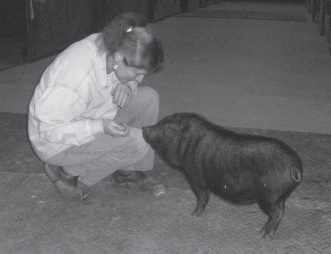
Sturgis, the latest rescue in the Miller household.
TABLE OF CONTENTS
This is a promising time for dogs in our culture. While some trainers and authors claim that we love our dogs too much in this country, treat them like humans, and spoil them, I think we are just beginning to love them enough. The number of dogs in shelters has decreased significantly in the last thirty-plus years, which means many fewer dogs die of homelessness each year. When I started working in animal protection in 1976, some 18-20 million surplus dogs and cats were euthanized each year. Today, in 2010, that number is three to four million. Still far too many, but certainly far fewer.
If it offends you to hear our beloved animal companions referred to as surplus, rest assured that it offends me too. Yet thats exactly how theyve been regardedand treatedfor much of the time Ive worked with animals professionally. Not because those who work at animal shelters are callous, or dont care, but because theyve had no choice. Shelter workers are often blamed when animals are euthanizedbut the animal protection professionals Ive worked with are among the most compassionate, caring people I know. It hurts their hearts every time they are compelled to euthanize healthy animals simply because there arent enough homes.
And there arent. Despite the claims of those who would argue that if shelters just tried harder they wouldnt have to euthanize any animals, the truth is that we arent yet at the point where every animal can find the lifelong loving home that he or she deserves.
The no-kill movement has raised public awareness of the pet-overpopulation tragedy, but the solutions they offer are simplistica bright promise for a future time, but not yet a reality. While shelter workers try their hearts out to save the lives of the animals they care for, the simple truth is that until fewer puppies are born, and until more humans learn how to communicate with, and understand, and make a lifetime commitment to the dogs they adopt, our canine companions will continue to die at animal shelters for lack of homes.
So what does this have to do with Do-Over Dogs? There was a time when the animal protection profession believed that if we could just spay and neuter enough animals, the killing would stop. Indeed, turning off the faucet, or at least turning it down to a relative dribble, has greatly reduced the puppy population in many shelters around the country. But shelter kennels are still well-populated with adolescent and adult dogs who somehow failed to make the connection with the humans in their homes that would ensure a lifetime of love and care. Animal protection and rescue professionals have come to realize that the next important piece of the puzzle, if we are ever to have hope of resolving the tragedy of unwanted pets, is behaviorof both dogs and humans.
No one gets a dog with the intention of giving it up. But even the best of intentions may falter when the realities of responsible dog ownership hit home. Sometimes the human has unrealistic expectations of the dog. She chews up everything in the house, one woman complains as she hands off the leash of her 16-week-old Shih-Tzu. Oh, and she pees on the oriental carpet. Shelter workers bite their tongues to avoid responding with, Well duh, shes a puppywhat did you expect? Did you even try to housetrain her?
With leisure time at a premium in our society, some people just dont realize that they cant crate a dog routinely for ten hours a day while theyre at work without suffering behavioral consequences. Tired from a hard day at the office, they come home to a soiled crate and a Border Collie who is bouncing off the walls with pent-up energy and poo-covered paws, insistent on playing with his humans. The humans just want a calm dog who will lie at their feet and gaze lovingly at them while they eat dinner and watch television. Too hyper, they sigh as they surrender the eight-month-old dog dancing at the end of the leash.
Sometimes the behaviors that lead a dog to a shelter are more serious. A young couple tearfully gives up their five-year-old German Shepherd mix because hes growling at the new baby. For five years, Fritz was their only child and none of their friends had children, so Fritz was never socialized with small humans. They cant risk the safety of their human child, so Fritz must go.
Petunia, a striking brindle-and-white American Pit Bull Terrier, was picked up as a stray and given her name by shelter staff. Petunia is afraid of her own shadow. No one knows why, since she was a stray, but she trembles in the back of her kennel and avoids eye contact with all humans.
These are Do-Over Dogs. The shelter is now faced with trying to find permanent homes for a puppy who has learned that the entire house is her chew toy and that carpeting is to pee on; a high-energy herding dog who has had no training and who has been taught to soil his den; a large dog who has a history of being aggressive with children; and a poorly socialized dog who, in many circles, already has two strikes against her just by virtue of her breed.
The best shelters and rescuesthose that recognize the important role that behavior plays in creating a permanent relationship and have the funding to do something about ithave behavior departments that work with dogs such as these to repair the damage done by unaware, unthinking or uncaring humans. The best rescue groups commit resources to behavior modification for the dogs who are in their kennels and foster homes. The best owners commit to sharing their hearts and homes with their dogs for life, and do whatever it takes to manage or modify their dogs problematic behaviors.
Next page
